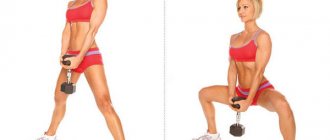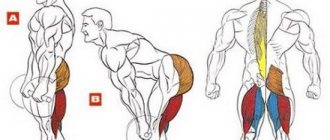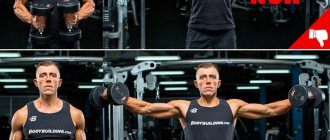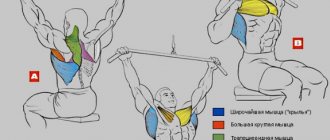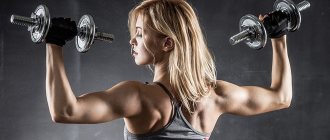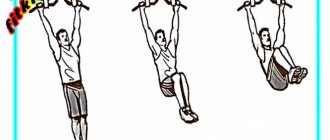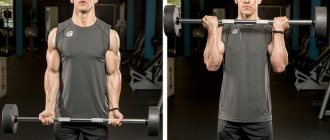The squat is a basic exercise that perfectly works the muscles of the legs and buttocks. It plays an important role in women's strength training and can also be done for weight loss. When performed correctly, a squat provides load to many muscles at once.
Girls can be advised to do it in the gym, but you can do the squat at home. There is no need to be afraid of barbells and dumbbells when doing squats - they will help you create elastic buttock muscles and always look fit and young. You can perform a squat in different ways, it can be a classic low squat with a small barbell, a squat performed in a Smith machine, a wide and deep squat (plie variation), a frontal squat, a squat with dumbbells and others. The correct technique for performing a squat necessarily includes a warm-up.
Warm-up
Squat down as deeply as possible, then jump up. Repeat this 10-15 times, after which you can run in place or on a treadmill for 5-7 minutes and start squatting. This warm-up will warm up the muscles of the buttocks. If the weights when performing a squat are already quite large, you need to squat several times with fewer weights or an empty bar before doing it.
Correct squat technique
How to do a squat for beginners? You don't need a barbell or squat rack to learn this. Take something very light instead of a bar and you can hone your technique, which is the key to successful training, strengthening your butt and losing weight.
To begin, you need to stand up straight with your feet approximately shoulder-width apart, providing support. The feet should be turned slightly to the side. You need to keep your back straight, and you shouldn’t try to strain it too much, straightening it unnaturally. It just needs to be level. Look forward, you can look up a little.
The squat rack should be in front of you. Take the bar from it and place it on your shoulders as comfortably as possible so that you can feel the emphasis. When learning the technique, as well as performing a squat with an empty bar, you can do without a stand and bar, and keep your hands in front of you. Special advice for women: since placing the barbell for girls on the upper trapezoids is often uncomfortable, you can slightly turn your chest and shoulders. As a result, these muscle bundles will relax and form a soft cushion for the bar.
After this, you can begin to perform a squat, guided by the following instructions:
- You need to look slightly up all the time, this will allow you to maintain a correctly aligned back. During the exercise, you should never look away to the side or even down.
- At the same time, you need to watch your posture, the main thing is that there is no hump.
- As you go down, be sure to move your buttocks back.
- You need to breathe as follows: gradually while performing a full squat, inhale, and while doing the lift, exhale.
- The feet should be pressed against the floor with their entire surface, because good support is important. Heels should not be lifted off the floor.
- The knees should diverge slightly to the side; bringing them closer is a gross mistake. But at the same time, they should not go beyond the line of the thumbs.
The classic full squat is performed until your thighs are parallel to the floor, after which you also rise smoothly. In this case, you must follow all the same rules as when going down. After the squat, rest for 5-10 minutes before performing another exercise.
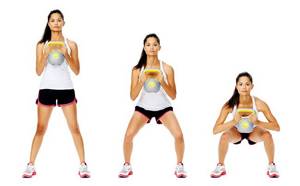
Deep squat 140 degrees or squat 90 degrees: which turned out to be more effective
The relative increase in one-rep max in the full squat was significantly greater in the FST (31.8%) than in the HST (11.3%), while for the half squat there was little difference between the FST (24.2%) and the HST (32. 0%).
These results are obvious - the principle of specificity in relation to the motor skill being developed. To maximize the development of strength in a particular exercise, you need to perform this particular exercise, and not with similar biomechanics.
Since, despite the fact that when performing similar exercises the same muscles can develop, the coordination of their mutual work with each other will be different. Therefore, the one who did full squats showed the greatest strength in them.
In the half-amplitude squat, the difference in maximum strength between participants is small, since both were actually working in the range from 0 to 90 degrees. Only some stopped there, while others sank even lower.
What muscles work during a squat?
This exercise targets the hip rotators, gluteus minimus, and gluteus medius. The lower legs are stabilized by the ankle muscles as well as the calf muscles. The muscles of the body also work - the muscles of the abdomen, lower back, and also those responsible for straightening the spine. This complex effect causes a significant consumption of calories, which is very good for women losing weight. The benefits are undeniable - doing squats (either in the gym or at home) is recommended for all girls.
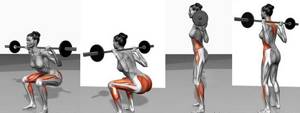
Hamstring muscle growth does not depend on squat depth
The volume of the hamstring muscles (the muscles of the back of the thigh) in both groups increased minimally - less than 1%. Here the situation is similar with the rectus femoris muscle - simultaneous contraction and stretching, a decrease in the degree of participation in work.
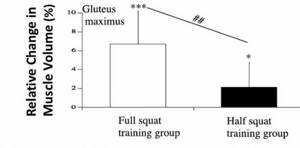
Types of squats for girls
- Classical. This option is described in the instructions above; it is the most common.
- Sumo (wide plie). This squat is distinguished by a wide stance of the legs (like sumo wrestlers). This allows you to work the muscles of the inner thigh more strongly, even with less weight. Another feature of plie is that the pelvis almost does not move back when performing it.
- Frontal option. The front squat is different in that the barbell is held on the chest with arms folded crosswise. It can be performed with light weights, without racks and at home. It is very good to perform it for weight loss with minimal load, but in a large number of repetitions.
- Incomplete. This squat is not performed to parallel. It is less effective for the buttocks, but is suitable for women with problems with the knee joints.
- Narrow squat. Unlike plie, here the legs are placed narrower than in the classic version. With this squat, you can take more weight with less amplitude, which can give impetus to the development of the leg muscles.
- In the Smith machine. The squat performed in the Smith machine is different in that the barbell in this machine moves up and down along guides. Exercises in this form are much safer, but with it the stabilizer muscles do not work, so the load is less. This option is worse for losing weight, but for developing the muscles of the buttocks it is good.
- Squat with dumbbells. Great for training at home. Racks for this option are also not needed. When doing this, keep the dumbbells in your lowered hands, so you don’t have to raise them.
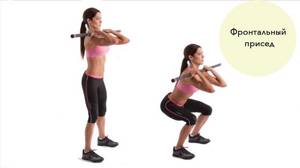
Types of squats
Work of muscles and joints
When performing any squats, in particular deep ones, almost all muscles are activated, so the squat is one of the main exercises in the training of athletes. But, if in bodybuilding squats the main load can be concentrated in the quadriceps, then the deep squat actively includes the back, back of the thigh and buttocks. In the lower phase of the range of motion, the buttocks receive a colossal load, but, nevertheless, this type of squats is not suitable for girls, since, in addition to the buttocks, such a squat stimulates hypertrophy of all other muscles that girls should not hypertrophy.
It works a lot of joints; squats, in general, are a multi-joint basic exercise, but in this case, since you squat deeply, at the bottom point your butt “nods down,” which creates an excessive load on the lumbar spine. That is why you should go down slowly and under control, and not drop the body with a stone, increasing the speed of movement after the point of passing the “parallel”. In this case, the main task of the athlete is to maintain all points of support, because if you shift the center of gravity from the middle of the foot, for example, by leaning forward excessively, then you will have to spend energy returning the body to the optimal position, as a result of which the working weight will have to be reduced.
What to expect after a squat?
When performing squats, girls sometimes notice nausea. This is typical only for heavy sets. With heavy weights, at which nausea is felt, insurance on the squat being performed becomes important. Alternatively, you can perform heavy squats in a separate Smith machine.
If the muscles of your legs and buttocks hurt the first time after a squat, this is normal. Over time they adapt. But if your knees hurt, then it is better to use bandages for the squat, and reduce its depth.
Scientists' conclusions about the effectiveness of squat depth
The results of the study show that full squat training is more effective for developing the muscles of the lower extremities, with the exception of the rectus femoris and hamstring muscles. If the goal of performing squats is to develop the gluteal and adductor muscles, then the full amplitude is preferable. In practice, due to individual anatomy, full squats may provide little benefit in developing the buttocks for some, although it will still be better than half-amplitude squats. When the goal is maximum hypertrophy, for the full development of the hip, squats alone are not enough. A little isolation wouldn’t hurt, for example, flexions or hyperextensions for the hamstrings and extensions; in them, the rectus muscle works more efficiently than in different variations of squats.
Home Squat Program
The squat is an energy-consuming exercise. It is worth training once or twice a week, using a split program for different muscle groups. But if you do it for weight loss, you can include it in a circuit training program 3 times a week. The optimal squat training for a beginner is 10-12 repetitions (3-4 sets). At first, don’t think about how to increase your squat, focus on your technique. After a while, seeing the first results, gradually increase the load - more repetitions and more approaches.
Program for training at home without a bar or with light weights
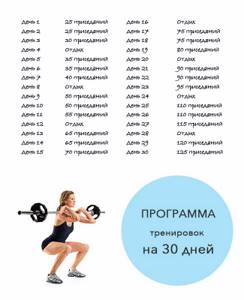
To achieve greater results, stick to the right diet. We recommend that you familiarize yourself with the BUCH nutrition system and the body drying program for girls.
Cons of Execution
If there is poor stretching and flexibility in the hip joint, you should not perform a load; this can be traumatic. Also, if you have no idea about the technique, you can seriously harm your body in the process.
Heavy squats with a barbell create a large load not only on individual muscle groups, but also on the entire musculoskeletal system. As a result, stretch marks and tendon ruptures occur. Of course, the usefulness of the exercise is great, but it is not worth performing it without prior preparation and increasing endurance.
Choosing too much weight makes it difficult to follow the technique, violation of which leads to bad consequences. Active deep squats put stress on the knee joints, which can also lead to problems.

Possible danger lies in squatting and bending your knees at an acute angle. If you can do this without weight without problems, then additional load leads to pain and injury. Special sports equipment does not always help solve the problem. Therefore, without a certain level of endurance, it is better not to perform loads.


